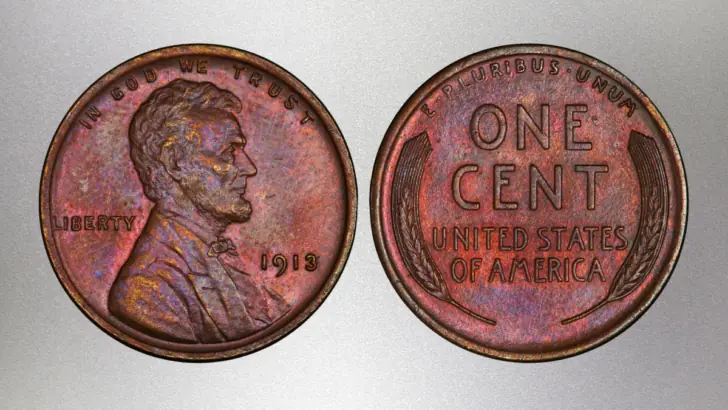The year 1913 saw a number of milestones in American history. In October 1913, President Woodrow Wilson officially opened the Panama Canal. In that same month, the Lincoln Highway, the first transcontinental highway route in the United States was also dedicated. Of interest to banknote collectors, the Federal Reserve Bank system was created. Henry Ford introduced the moving assembly line for automobiles, and the New York World introduced the crossword puzzle.
In film, Charlie Chaplin signed his first contract to make movies, while Mary Pickford, already an established silent film star, signed a contract for the astonishing sum of $500 per week. Feature length releases included Quo Vadis, and the Last Days of Pompeii, both feature length films based on well-known novels.
Al Jolson described the plight of the early driver, with the song “He’ll have to get under, get out and get under to fix up his automobile.”
In addition to spending a few pennies to see a film, or to buy a paper with a crossword puzzle, or saving pennies to buy an early model Ford, Americans could look forward to the introduction of an income tax, though few taxpayers were initially affected.
Production of the 1913 Lincoln Wheat Penny
| Type | Philadelphia | Denver | San Francisco |
| 1913 | 76,529,504 | 15,804,000 | 6,101,000 |
| 1913 Proof | 2,848 | 0 | 0 |
The mintage numbers for both 1912 and 1913 were small, compared to previous years, and much smaller than we are accustomed to seeing today. Many of the coins had very hard use in circulation. Wheat pennies for 1913 are accordingly scarce in all grades, and can command significant prices in the market. The very highest grades of mint-state coins can be extremely valuable, but even the circulated grades can fetch surprisingly high prices.
Values for the 1913 Lincoln Wheat Penny
| 1913 Penny Value Chart | |||
| Business Strike | Grade | ||
| Uncirculated MS64 | Uncirculated MS65 | Uncirculated MS66 | |
| 1913 1C BN | $68.00 | $156.00 | — |
| 1913 1C RB | $108.00 | $260.00 | $520.00 |
| 1913 1C RD | $182.00 | $494.00 | $1,380.00 |
| 1913-D 1C BN | $260.00 | $585.00 | — |
| 1913-D 1C RB | $358.00 | $650.00 | $1,020.00 |
| 1913-D 1C RD | $819.00 | $1,750.00 | $4,000.00 |
| 1913-S 1C BN | $422.00 | $1,090.00 | — |
| 1913-S 1C RB | $585.00 | $1,380.00 | $6,250.00 |
| 1913-S 1C RD | $1,220.00 | $4,620.00 | $21,600.00 |
| Proof Strike | Grade | ||
| PR64 | PR65 | PR66 | |
| 1913 1C BN | $728.00 | $936.00 | $1,280.00 |
| 1913 1C RB | $858.00 | $1,110.00 | $1,440.00 |
| 1913 1C RD | $1,050.00 | $1,250.00 | $2,380.00 |
Coin values depend upon supply and demand, and upon the quality of the individual specimen under consideration. Supply is limited by the mintage number issued by the Mint in any given year. That number can only go down over time, as coins are lost, hoarded, or melted. Demand is somewhat idiosyncratic. Some coins, usually centered on the first year of a pattern’s issuance, or its last year, may be popular with collectors generally. In other cases, the price received at auction could depend upon the bidders present on the day. A collector needing to fill a gap in the collection may bid, and bid well. Once that desire is met, other bidders may not be interested.
The quality of a coin is known as its grade. An extensive discussion of grading is beyond the scope of this article, but has been extensively covered in this article. For our purposes, it is enough to note that collectors distinguish between coins that have been used in commerce, called circulated, and those which have never been used in commerce, called “mint-state” or uncirculated. Uncirculated bronze coins are also described by their tone, which can be either “brown,” (abbreviated BN), “red-brown,” (abbreviated RB), or “red,” (abbreviated RD).
Values for circulated grades of the 1913 Lincoln penny
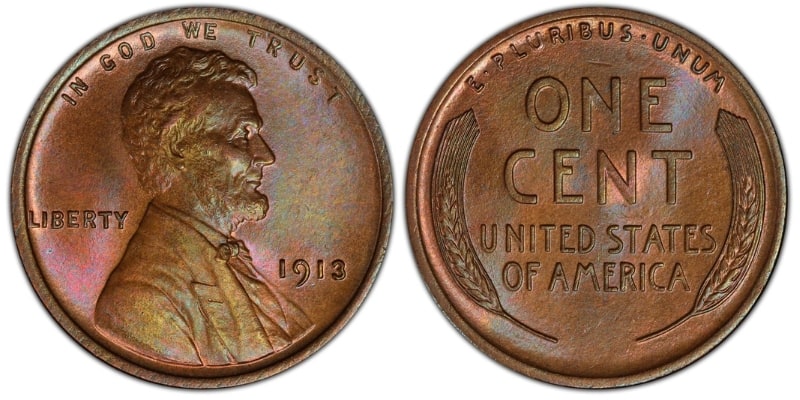
Despite having tens of millions of coins available, the 1913 Lincoln penny is old enough that few choice specimens remain, either circulated or uncirculated. Beginning collectors seeking to fill up a penny book will have to settle for good or fine grades. The vast majority of coins were struck by the Philadelphia Mint, and so carry no mint marks. Such coins are readily available in the “good” grade, and can be purchased for a little over half a dollar. A fine specimen from Philadelphia should cost under $2.25.
Coins from Denver and from San Francisco are much less frequently met with. Wheat pennies from Denver, in the good grade, should cost about the same as coins in the fine grade from Philadelphia, between $2.25 and $2.50. Wheat pennies from San Francisco are rarest of all. In the good grade, they should cost something under $10.00. In the fine grade, these coins take a step-up in value, and cost over $3.00, in the case of wheat pennies from Denver, and over $15.00, in the case of wheat pennies from San Francisco.
Extremely fine grades of coin, which are much more common in more recent years, are somewhat more scarce and quickly become suitable objects of interest for auction houses. Thus in November 2023, Heritage Auctions sold a 1913-S wheat penny, graded AU-58 for $129.00. An identically graded 1913-D wheat penny sold in January 2023 for $104.00. Even a 1913-S XF-45 wheat penny can fetch $65.00 at auction. These are not coins to tuck away in that blue penny folder, but to keep carefully in plastic holders.
Values for uncirculated grades of the 1913 Lincoln penny
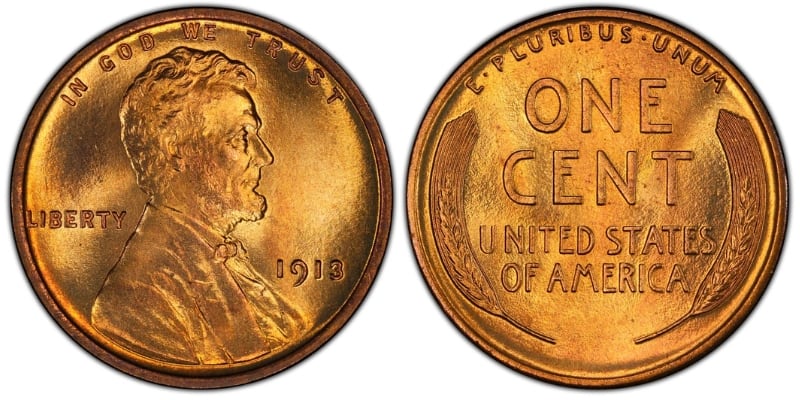
Although the 1913 wheat penny had over 76,000,000 coins minted, the age and the heavy use given the coin means that comparatively few remain in the better uncirculated grades. Fewer still retain the original nice copper-red coloration, having oxidized instead to red-brown or brown. Prices commanded for prime specimens at auction are high and out of the reach of all but the wealthiest collectors.
In November 2023, Heritage Auctions sold a 1913 wheat penny, graded MS-67+ for $60,000. The sale catalog states that the numismatic certification services have not graded any specimens higher.
As is often the case with collectible coins, slight differences in grade lead to large swings in price. A 1913 MS-66+ RD wheat penny sold in May 2023 for only $4,080 at Heritage Auctions. The distinction between these two coins from Philadelphia would be hard to see with the naked eye.
Since there were far fewer coins struck by the Denver and San Francisco Mints, the prices for uncirculated issues are correspondingly higher. In November 2023, a 1913-D MS-66+ RD wheat penny sold for $9,900. This is essentially the same grade of coin as the less valuable of the two Philadelphia specimens discussed above. There is little to choose between the two coins in appearance or quality. The mint mark is the distinguishing feature of value.
At grades of MS-64 or less, prices take another step down, in favor of the purchaser and collector. They remain expensive, however. A 1913-S MS-64 RB wheat penny sold for $576 at Heritage Auctions. A similar penny from the Denver Mint sold at Heritage Auctions in October 2023 for $312.00
At still lower mint-state grades, and in brown, rather than red or red-brown tones, prices for the 1913 wheat penny fall into the range of one hundred to two hundred dollars, where they become more accessible for collectors. A 1913-D MS-63 BN specimen sold for $198 in September 2023 at Heritage Auctions. That may still sound expensive, but it amounts to something like forgoing a premium hamburger at a fast food restaurant every day for a month.
Were any 1913 Proof Lincoln Wheat Pennies Produced?
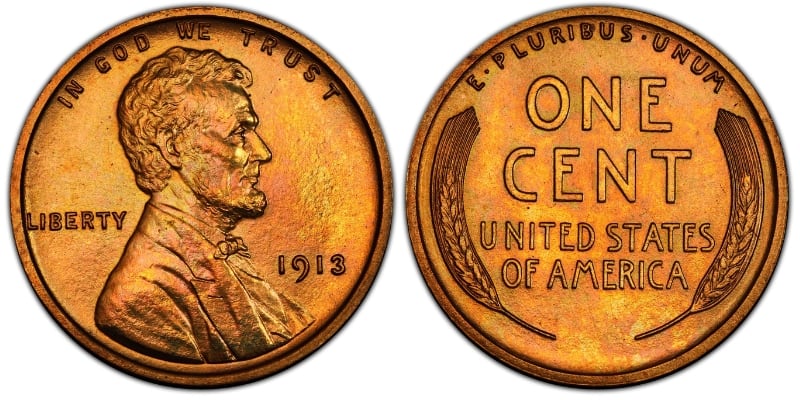
In 1913, the U.S. Mint produced just under 3,000 proof Lincoln Wheat pennies. The 1913 proof pennies had a matte finish, rather than the brilliant, mirror-like surface that is created today. Because of the age of the coins, and difficulties with the original packaging, which was chemically reactive, proof coins from that era often deteriorate to some extent, and good specimens are rare. Proof coins are graded using exactly the same numerical scale of 1 to 70, with the prefix “PR”. You can sometimes find circulated proof examples at auction; these are referred to as “impaired proofs.” You can also find brown and red-brown proof specimens, as well as red examples. As with uncirculated “Mint-State” coins, higher grades are favored by collectors, and red coins fetch a better price than red-brown or brown specimens.
An example of this preference can be seen in the recent sale of three 1913 wheat pennies at Heritage Auctions. A PR-65 RB penny with much of its red tone still intact, but which had a mottled iridescent appearance from corrosion, sold for $870 in January 2023. In May 2023, a PR-66 RB penny, with better red tone than the previous example, but with some unexplained white spots, sold for $1,200. A red-brown penny of exactly the same grade, but lacking those spots, fetched $2,040 in February 2023.
Proof Lincoln pennies from 1913 retaining the original red tone fetch good prices at auction. A 1913 PR-64 RD penny sold for $750 in April 2023. The next step up in grade, PR-65, can command nearly twice the price, since just such a specimen sold in November 2023 at Heritage Auctions for $1,320.
Error Values for the 1913 Lincoln Wheat Penny
Off-center strikes of 1913 Lincoln wheat pennies
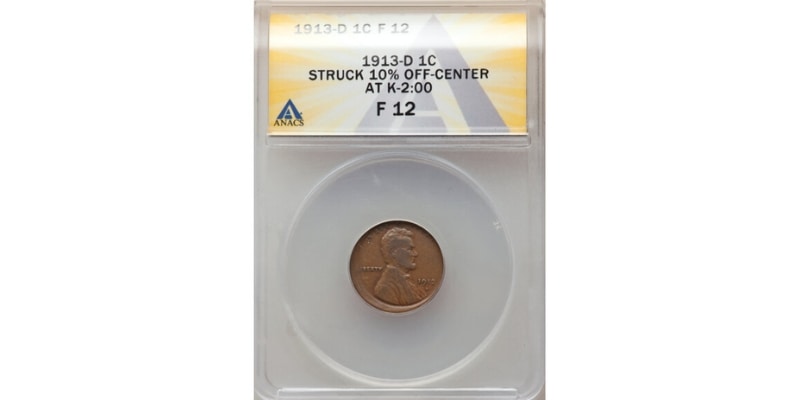
Coins are minted by striking a coin blank, called a planchet, between two dies. Ideally, the planchet lines up precisely between the two dies, and the result is a nice, round coin. Occasionally, the planchet is misaligned in the press, and the result is an “off-center” strike, an oblong shaped coin with part of the image missing. While the U.S. Mint exerts vigorous quality control checks, even a tiny fraction of a percent of defects can add up to a sizable number of coins actually reaching circulation.
Collectors avidly seek these defective coins, and off-center strikes tend to fetch higher prices than equivalently graded normal coins. In the case of off-center strikes, purchasers are interested in coins which have both the date and mint mark present.
One example of the premium attached to off-center strikes is a 1913-D, which was 10% off-center. The coin, graded F-12, would ordinarily sell for just under $3.50. The off-center error coin sold for $169 at Heritage Auctions in January 2022.
Other kinds of errors also entice collectors who specialize in the field. A defective planchet can exhibit “lamination,” where part of the coin flecks away during or after the striking process. This can occur because of deep defects in the metal itself, or weakness in the entire coin blank. The result will be a sort of scarring where the image is simply lost. Since such a coin can circulate for some while before being detected, it can be of any grade.
As an example, a 1913-S Lincoln wheat penny, exhibiting lamination on the obverse, or front side, graded F-15, sold for $43.00 at auction in May 2022. A similar coin, with no defects, should sell for between $18 and $20.00, so the loss of a few tiny flakes of metal, paradoxically, doubled the value.
Another manufacturing defect that can occur in the minting process involves the collar, which is supposed to hold the planchet on the die. Ideally, the coin sits correctly in the collar, and flat against the die. If the planchet tilts, the collar will not hold it correctly, and part of the coin will flow away from where the rim should be. This is called a “tilted partial collar error.” Again, such coins can circulate before being detected by a collector, and so may be of any grade. A 1913 Lincoln penny with a tilted partial collar, graded AU-55, sold for $66.00 in January 2022 at Heritage Auctions. A correctly struck example of the same coin should cost a bit over $30.
Technical Specifications of the 1913 Lincoln Penny
The year 1913 was the fifth year in which the Lincoln wheat design was used for the one cent piece. The coin had been introduced in 1909 to memorialize the one hundredth anniversary of the birth of Abraham Lincoln the Sixteenth President of the United States. The designer of the coin, Victor D. Brenner, was commissioned after he prepared a bust of then-President Theodore Roosevelt. Roosevelt, who was interested in artistic matters, wished to improve the appearance of U.S. coins. For the penny, Brenner created a profile portrait of Lincoln for the front of the coin, and a pair of stylized wheat stalks to surround the words “one cent” on the back. The design was immediately popular and has continued as the longest running U.S. coin design.
The 1913 wheat penny is a bronze coin with a weight of 3.11 grams and a diameter of 17 millimeters. It is made from 95% copper, and 5% tin and zinc.
Summary
The 1913 penny is somewhat of a paradox. It is sufficiently common that collectors should be able to find something at a variety of price points. But it is not so common as to depress prices for the nicer coins. Beginning collectors can expect to pay well for coins from Denver and to pay a premium for coins from San Francisco. Collectors simply hoping to fill up a penny folder will probably settle for coins with a much lower grade than they are accustomed to seeing in later years. Higher circulated grades command a much higher price, and may be unattainable for beginning collectors, or collectors working with a limited budget.
Uncirculated “mint-state” wheat pennies are much less common in the year 1913. Collectors can expect to pay prices in excess of $100 for all but the lowest grades of red mint-state coins. Red-brown and brown coins are more readily available. The very highest grades of red coins are so rare as to be museum-worthy objects, with prices to match. All but the wealthiest collectors will settle for either lower grades, less attractive tone, or both.
In short, the 1913 wheat penny may prove a challenge for collectors and a burden for their wallets.
